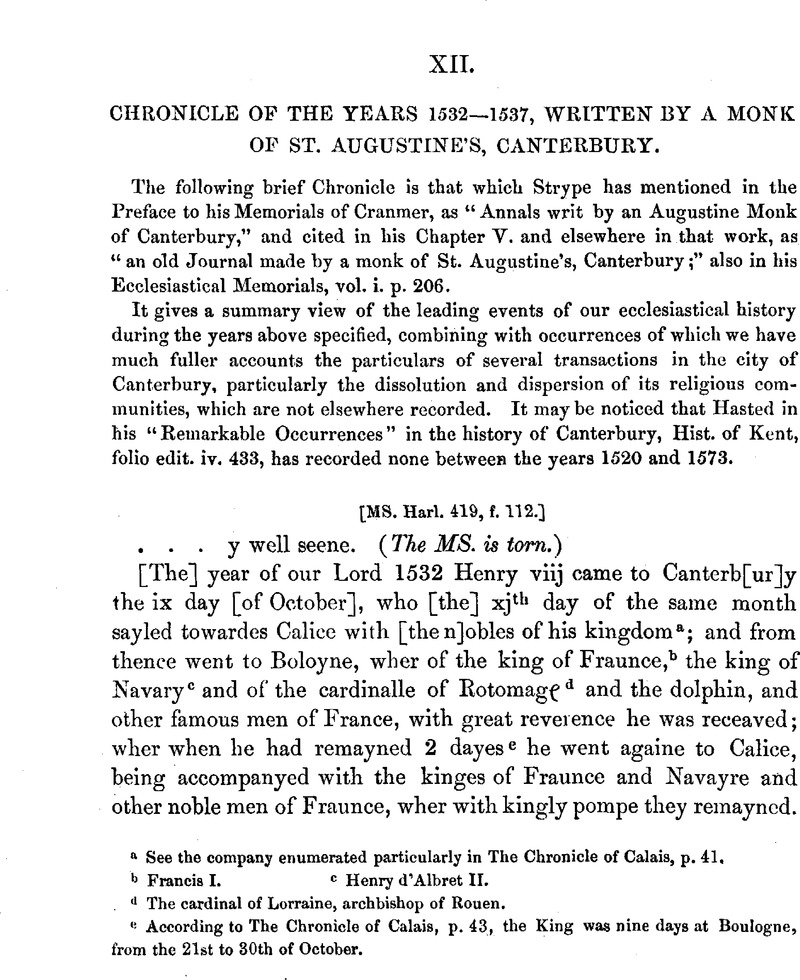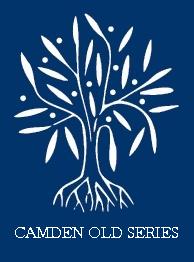No CrossRef data available.
Article contents
XII. Chronicle of the Years 1532–1537, written by a Monk of St. Augustine's, Canterbury
Published online by Cambridge University Press: 23 February 2010
Abstract

- Type
- Narratives of the Days of the Reformation
- Information
- Copyright
- Copyright © Royal Historical Society 1859
References
page note 279 a See the company enumerated particularly in The Chronicle of Calais, p. 41.
page note 279 b Francis I.
page note 279 c Henry d'Albret II.
page note 279 d The cardinal of Lorraine, archbishop of Rouen.
page note 279 e According to The Chronicle of Calais, p. 43, the King was nine days at Boulogne, from the 21st to 30th of October.
page note 280 a i. e. was inthroned in the cathedral church, according to ancient usage.
page note 280 b A summary of this well-known matter will be found in the volume of “Letters relating to the Suppression of the Monasteries,” edited for the Camden Society by Mr. Thomas Wright, at p. 13, followed by several original papers relating to it.
page note 280 c The culprits were altogether six in number : Elizabeth Barton, a nun of the house of St. Sepulchre at Canterbury ; doctor Edward Booking and Richard Bering, monks of the house of the Holy Trinity, or Christ church, Canterbury ; Henry Gold, rector of St. Mary Aldermary in London ; Hugh Rich, warden of the friars observants at Canterbury; and Richard Rigby, one of his brethren. See another account of their penance in the Chronicle of the Grey Friars of London, p. 37.
page note 281 a The paper is here torn.
page note 281 b The execution of the holy maid and her followers was on the 5th of May, according to the Chronicle of the Grey Friars, p. 37. Mr. Wright (uhi supra) places it on the 20th of April, probably in consequence of Strype (Memorials of Cranmer, p. 22) having misapprehended the purport of this imperfect paragraph.
page note 281 c The words “friers” is written above “brethren.” It is probable that these notes were at first written in Latin, and translated.
page note 281 d By act 26 Hen. VIII. cap. 1; Statutes of the Realm, iii. 492.
page note 282 a By proclamation dated the 9th of June, which is printed in Foxe's Actes and Monuments.
page note 282 b Some of the brethren of the writer's house, countenanced by the prior (Groldwell), were specially charged with resisting this change: “the sayde pryour hadde takyne a collette ffor the bysshoppe of Rome by name of Pope, contrarye to his othe and a lawe made in that behalfe.” Christopher Levyns to Crumwell, in Wright's collection, p. 90.
page note 282 c Dr. Richard Layton, the writer of many of the “Letters relative to the Suppression of the Monasteries,” edited by Mr. Wright.
page note 282 d The principal visitors, under the direction of Crumwell the King's vicegerent or vicargeneral, were doctors Layton, Legh, Petre, and London. See Strype, Eccles. Memorials, i. 206 : and Mr. Wright's volume, passim.
page note 282 e Richard Bartelot, who occurs in Mr. Wright's volume at pp. 59, 75.
page note 282 f Or the Holy Trinity, Canterbury.
page note 283 a Randle Brereton.
page note 283 b Mark Smeaton.
page note 283 c Sir John Seymour, a knight only.
page note 284 d Thomas Goldwell, prior of Christ church, Canterbury, from 1515 until its dissolution in 1539, when a yearly pension of 80l. was assigned to him, together “with the office of one of the prebendaries there.” He was the prior who received Erasmus on his visit to Canterbury, and is thus mentioned in the Colloquy on Pilgrimage for Religion's sake. “He appeared to me to be a man equally pious and judicious, nor unskilled in the Scotian theology (i. e. of the school of Duns Scotus.)”
A letter written by him to Crumwell relative to Elizabeth Barton is printed in Mr. Wright's collection, at p. 19. In another letter in the same volume (p. 90) addressed to Crumwell by Christopher Levyns, there are many grave charges against Goldwell, among the rest that he had murdered divers monks of his house.
page note 283 e William Lambarde in his Perambulation of Kent, written in 1570, speaking of Dover, says that “now in our memorie, what by decay of the haven, which king Henrie the eight with the cost of 63,000 pounds upon a piere, but all in vaine, sought to restore, and what by the overthrowe of the religious houses, and losse of Calaice, it was brought in manner to miserable nakednesse and decay.” (Edit. 1596, p. 147.) In the History of Dover, by the Rev. John Lyon, 4to. 1813, vol. i. p. 153, will be found an account of the works carried on in the reign of Henry VIII. for erecting a pier at Dover, which were commenced on St. Anne's day (July 26) 1533. See also a discourse written by Thomas Digges, esq. about 1582, in the Archæologia, vol. xi. ; and “A Discourse of Sea Ports, principally of the Port and Haven of Dover, by Sir Walter Raleigh, published by Sir Henry Shears, 1700.” 4to.
page note 284 a William Petre, “who was then, if I mistake not, master of the faculties to the vicegerent, lord Crumwell, and afterwards secretary of state.” Strype's Cranmer, p. 55. See Wright's Letters relating to the Suppression of the Monasteries.
page note 284 b See Chronicle of the Grey Friars of London, p. 39.
page note 284 c A priory of Black canons in Canterbury; see the Monasticon Anglic, new edit. vi. 614.
page note 284 d Misprinted by Strype (Eccles. Memorials, i. 472) “mr. Spitman and mr. Candel.”
Thomas Spilman, of Canterbury, gentleman, was the grantee of the house of Grey Friars in that city, and of other church lands. The latter was William Cavendish, afterwards treasurer of the chamber, and a knight; see Collins's Peerage, tit, Devonshire.
page note 284 e A house of Benedictine nuns in Canterbury : see Monasticon Anglicanum, new edition, iv. 413 ; Hasted's Kent, folio edit. iv. 449. Elizabeth Barton had been a member of this house.
page note 285 a i. e. the nuns : misprinted “monks” by Strype, iibi supra.
page note 285 b See the Chronicle of the Grey Friars of London, pp. 40, 41.
page note 285 c The words “sonne of the lorde Tommas” must be a mistransoript. Lord Daroy's own name was Thomas. Strype printed these words as “son of the Lord L.”
page note 285 d Katharine of Arragon, then styled “princess dowager.”
page note 285 e These words are supplied from Strype, Mem. of Cranmer, p. 61.
page note 285 f On the 24th of October, twelve days after the birth of Edward VI.
page note 286 a The abbat of Abingdon, Thomas Pentecost alias Rowland, who had been one of the first to acknowledge the King's supremacy in 1531, surrendered his monastery on the 9th Feb. 1537–8, and for his ready compliance was allowed to retain for life his manor of Cumnor, where he died in the reign of Edward VI.
page note 286 b Surrendered on the 29th June, 29 Hen. VIII. 1537–8.
page note 286 c This shows the MS. to be a transcript, a word here not having been understood by the transcriber. The original no doubt read “the rood of grace,” which was the name by which this celebrated idol was known. It is described at some length in Lambarde's Perambulation of Kent: see also references to several contemporary letters upon its destruction in Gorham's Reformation Gleanings, 1857, p. 17.
page note 286 d John Hilsey.


